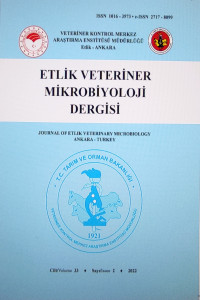Öz
Salmonella, Türkiye’de ve dünyada, insan ve hayvan sağlığını tehdit eden, gıda orijinli infeksiyonlar arasında en çok izole edilen zoonoz karakterli, önemli bir mikroorganizmadır. Özellikle ülkemizde sirküle olan yaygın serovarların tespiti ve izole edilen serovarların belirlenmesi hem hayvan sağlığı hem de insan sağlığını tehdit eden Salmonella’larla mücadelede oldukça faydalı verilere ulaşmamızı sağlayacaktır. Bu çalışmada Veteriner Kontrol Merkez Araştırma Enstitüsü Bakteriyolojik Teşhis Loboratuvarı’na gönderilen numunelerden identifiye edilen Salmonella serovarlarının dağılımı ve çeşitliliğini belirlemek amaçlandı. 2015-2020 yılları arasında izole edilip doğrulama ve serotiplendirme amacıyla 1,047 Salmonella spp. suşunun serotiplendirilme sonuçları retrospektif olarak değerlendirilmiştir. Gönderilen örnekler ISO 6579’a göre; izolasyonu yapılan kültürlerin Salmonella spp. olduğu doğrulandıktan sonra tür düzeyinde identifikasyonu lam aglütinasyon testle serotiplendirilerek gerçekleştirildi. Çalışmada 19 serogrup, 75 Salmonella serovarı tespit edildi. En yaygın izole edilen Salmonella serovarları sırasıyla Salmonella Infantis (40.5%), Salmonella Enteritidis (12.9%), Salmonella Abony (4.3%), Salmonella Kentucky (4.2%), Salmonella Typhimurium (4%), Salmonella Liverpool (2.4%) ve diğer serovarlar (31.3%) olduğu belirlendi. Tespit edilen en yaygın serogruplar ise sırasıyla grup C1 (48.2%), D1 (14.4%), B (12.4%), C3 (7.8%) ve E4 (4.2%)’tü. Tavuklarda en yaygın serovarlar Salmonella Infantis, buzağılarda Salmonella Montevideo, kaplumbağada Salmonella Darle, kuzuda Salmonella Typhimurium ve yaban kuşlarında Salmonella Hessarek idi.
Anahtar Kelimeler
Hayvanlar Salmonella serovarları Türkiye Hayvanlar, Salmonella serovarları, Türkiye
Kaynakça
- Akan M (2008): Kanatlılarda Salmonella infeksiyonları ve kontrolünde temel prensipler. Mektup Ankara, 6, 3-4.
- Alba P, Leekitcharoenphon P, Carfora V, et al (2020): Molecular epidemiology of Salmonella Infantis in Europe: insights into the success of the bacterial host and its parasitic pESI-like megaplasmid. Microb Genom, 6, e000365.
- Antunes P, Mourao J, Campos J, et al (2016): Salmonellosis: the role of poultry meat. Clin Microbiol Infect, 22, 110–121.
- Arda M (2006): Temel Mikrobiyoloji. Medisan, Ankara.
Öz
Salmonella is an important zoonotic microorganism and the most isolated among food-borne infections across the world, including Türkiye. The detection and identification of common serovars circulating in Türkiye can present very useful data in the fight against Salmonella, which threatens both animal and human health. This study aimed to determine the distribution and diversity of Salmonella serovars isolated from the samples sent to Bacteriological Diagnosis Laboratory of the Veterinary Control Central Research Institute. The serotyping results of a total of 1,047 Salmonella spp. strains isolated between 2015 and 2020 were retrospectively evaluated. After confirming that the samples isolated were Salmonella spp. according to ISO 6579, identification at the species level was carried out by serotyping with the slide agglutination test. A total of 19 serogroups and 75 Salmonella serovars were detected. The most commonly isolated Salmonella serovar was Salmonella Infantis (40.5%), followed by Salmonella Enteritidis (12.9%), Salmonella Abony (4.3%), Salmonella Kentucky (4.2%), Salmonella Typhimurium (4%), Salmonella Liverpool (2.4%), and other serovars (31.3%). The most commonly identified serogroups were C1 (48.2%), D1 (14.4%), B (12.4%), C3 (7.8%), and E4 (4.2%). According to animal species, the most common serovar was Salmonella Infantis in chickens, Salmonella Montevideo in calves, Salmonella Darle in tortoises, Salmonella Typhimurium in lamb and Salmonella Hessarek in wild birds.
Anahtar Kelimeler
Kaynakça
- Akan M (2008): Kanatlılarda Salmonella infeksiyonları ve kontrolünde temel prensipler. Mektup Ankara, 6, 3-4.
- Alba P, Leekitcharoenphon P, Carfora V, et al (2020): Molecular epidemiology of Salmonella Infantis in Europe: insights into the success of the bacterial host and its parasitic pESI-like megaplasmid. Microb Genom, 6, e000365.
- Antunes P, Mourao J, Campos J, et al (2016): Salmonellosis: the role of poultry meat. Clin Microbiol Infect, 22, 110–121.
- Arda M (2006): Temel Mikrobiyoloji. Medisan, Ankara.
Ayrıntılar
| Birincil Dil | İngilizce |
|---|---|
| Konular | Veteriner Cerrahi |
| Bölüm | Araştırma Makaleleri |
| Yazarlar | |
| Yayımlanma Tarihi | 23 Aralık 2022 |
| Gönderilme Tarihi | 2 Ağustos 2022 |
| Yayımlandığı Sayı | Yıl 2022 Cilt: 33 Sayı: 2 |


